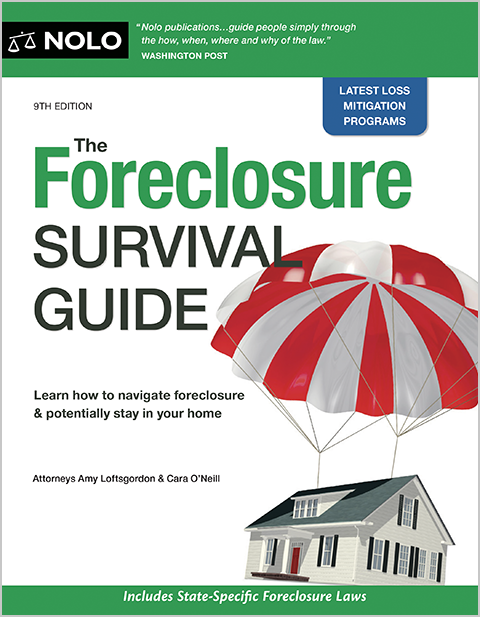Learn about Vermont's foreclosure laws and how the Vermont foreclosure process works.
Before the foreclosure crisis, federal and state laws regulating mortgage servicers and foreclosure procedures were relatively limited and tended to favor foreclosing lenders. Now, however, many federal and state laws give protections to borrowers. Servicers generally must provide borrowers with loss mitigation opportunities, account for each foreclosure step, and carefully comply with foreclosure laws.
Also, most people who take out a loan to buy a residential property in Vermont sign a promissory note and mortgage. These documents give homeowners contractual rights after a mortgage default.
So, don't get caught off guard if you're about to go through a foreclosure. Learn about the Vermont foreclosure process, from missing your first payment to a foreclosure sale.
- What Are My Rights During Foreclosure in Vermont?
- What Is Preforeclosure?
- Is Vermont a Judicial Foreclosure State?
- Foreclosure Mediation in Vermont
- What Are the Steps Involved in a Foreclosure by Judicial Sale in Vermont?
- What Are the Steps Involved in a Strict Foreclosure in Vermont?
- What Are the Options Available for Borrowers During Foreclosure in Vermont?
- Foreclosure Protections for Military Servicemembers
- Are Deficiency Judgments Allowed in Vermont?
- Learn More About Vermont Foreclosure
What Are My Rights During Foreclosure in Vermont?
In a Vermont foreclosure, you'll most likely get the right to:
- apply for a way to avoid foreclosure through a loss mitigation process
- participate in foreclosure mediation
- get notice of the foreclosure and the chance to respond in court
- receive special protections if you're in the military
- get current on the overdue amounts to stop the foreclosure sale
- pay off the total loan debt to prevent a foreclosure sale, and
- get any excess money after a foreclosure sale.
Once you understand the Vermont foreclosure process and your rights, you can make the most of your situation.
What Is Preforeclosure?
During "preforeclosure" (the period after you fall behind in payments but before a foreclosure officially starts), the servicer can charge you various fees, including late and inspection fees, and, in most cases, must let you know how to avoid foreclosure and send you a breach letter (a preforeclosure notice). Sometimes, people refer to the period before a foreclosure sale happens as "preforeclosure," too.
Under federal law, the servicer usually can't officially begin a foreclosure until you're more than 120 days past due on payments, subject to a couple of exceptions. (12 C.F.R. § 1024.41 (2025).)
Is Vermont a Judicial Foreclosure State?
If you default on the mortgage payments for your Vermont home, the foreclosure will be judicial. However, the process could vary from other states that use a judicial process.
While a "foreclosure by judicial sale" in Vermont is basically a typical judicial foreclosure, a "strict foreclosure" is a slightly different procedure. A strict foreclosure is allowed if the court finds the property has no substantial value over the mortgage debt plus the assessed but unpaid property taxes. (Vt. Stat. tit. 12, § 4941 (2025).)
Foreclosure Mediation in Vermont
Vermont law gives many homeowners in foreclosure the right to participate in mediation. (Vt. Stat. tit. 12 § 4631, et seq. (2025).)
What Are the Steps Involved in a Foreclosure by Judicial Sale in Vermont?
A foreclosure by judicial sale begins when the foreclosing lender files a lawsuit (a "complaint") in court and serves a copy and a summons to the borrower. (Vt. R. Civ. P. 80.1 (2025).) The summons informs the borrower about the deadline to file a response, called an "answer," with the court, which is generally 21 days after the complaint and summons are served. (Vt. R. Civ. P. 12(a)(1)(A) (2025).)
If the borrower doesn't respond, the lender automatically wins the case. But if the borrower responds to the suit, the court will move the case through the litigation process. Either way, if the lender wins, the court enters a judgment against the borrower and sets a sale date.
The lender mails a notice of the sale to the borrower no fewer than 30 days before the sale and publishes the notice in a newspaper no fewer than 21 days before the sale. (Vt. Stat. tit. 12, § 4952 (2025).) The home is then sold at a foreclosure sale.
How Do Vermont Foreclosure Sales Work?
At the sale, the lender usually makes a credit bid. The lender can bid up to the total amount owed, including fees and costs, or it may bid less. In some states, including Vermont, when the lender is the high bidder at the sale but bids less than the total debt, it can get a deficiency judgment against the borrower.
The property becomes "real estate owned" (REO) if the lender is the highest bidder. But if a bidder, say a third party, is the highest bidder and offers more than you owe, and the sale results in excess proceeds—that is, money over and above what's needed to pay off all the liens on your property—you're entitled to that surplus money.
What Are the Steps Involved in a Strict Foreclosure in Vermont?
The main difference between a foreclosure by judicial sale and a strict foreclosure is that in a strict foreclosure, the court enters a judgment and transfers the property directly to the lender without holding a sale. (Vt. Stat. tit. 12, § 4941 (2025).)
Making a Motion for Foreclosure by Judicial Sale
In a strict foreclosure, you may file a motion for a judicial foreclosure sale. This motion asks for an auction to sell the home to the highest bidder. (Vt. Stat. tit. 12, § 4941 (2025).)
What Are the Options Available for Borrowers During Foreclosure in Vermont?
A few potential ways to stop a foreclosure might include reinstating the loan, redeeming the property, or filing for bankruptcy. Of course, if you can work out a loss mitigation option, like a loan modification, that will also stop a foreclosure.
Reinstating the Loan in a Vermont Foreclosure
Under Vermont law, in a foreclosure by judicial sale, the borrower has the right to reinstate the loan after the redemption period (see below) set forth in the judgment expires, but before the sale, if both the borrower and the lender agree. (Vt. Stat. tit. 12, § 4948 (2025).)
Your mortgage contract might also give you the right to reinstate the loan by a specific deadline. Or your lender might agree to let you complete a reinstatement.
What Is the Right of Redemption in a Foreclosure in Vermont?
One way to stop a foreclosure is by "redeeming" the property (paying the lender the full amount of the outstanding mortgage loan plus all applicable costs and expenses).
Redemption period in a foreclosure by judicial sale. In a foreclosure by judicial sale, the redemption period for an owner-occupied principal residence is six months from the date of the foreclosure decree unless the court orders a shorter time. (Vt. Stat. tit. 12, § 4946(b) (2025).) In addition, if the borrower occupies the house as a principal residence at the time the lender applies for an entry of judgment, the sale can't take place until at least seven months after the lender serves the complaint unless the court orders a shortened redemption period or the borrower agrees to it. (Vt. Stat. tit. 12, § 4946(b)).
The borrower can also redeem the home at any time before the sale after the initial redemption period expires. (Vt. Stat. tit. 12, § 4952 (2025).)
Redemption period in a strict foreclosure. In a strict foreclosure, the borrower may redeem the property within six months from the date of the foreclosure decree, unless:
- the court orders a shorter redemption period, or
- the borrower and the foreclosing lender mutually agree to a shorter period. (Vt. Stat.tit. 12, § 4941 (2025).)
Filing for Bankruptcy
If you're facing a foreclosure, filing for bankruptcy might help. A Chapter 7 bankruptcy might delay the foreclosure for a couple of months. Or, if you want to save your home, filing for Chapter 13 bankruptcy might be the right choice. Chapter 13 bankruptcy allows you to pay the mortgage arrears through a three- to five-year repayment plan. To find out the options available, speak with a local bankruptcy attorney.
Foreclosure Protections for Military Servicemembers
The federal Servicemembers Civil Relief Act provides legal protections to military personnel at risk of foreclosure.
Are Deficiency Judgments Allowed in Vermont?
In a foreclosure, the borrower's total mortgage debt sometimes exceeds the foreclosure sale price. The difference between the total debt and the sale price is called a "deficiency."
For example, if the borrower's total debt owed is $700,000, but the home sells for $650,000 at the foreclosure sale, the deficiency is $50,000. In some states, the lender can seek a personal judgment against the debtor to recover the deficiency. Generally, once the lender gets a deficiency judgment, the lender may collect this amount ($50,000 in the example above) from the borrower.
Deficiency judgments are allowed in Vermont.
Deficiency Judgment in a Vermont Foreclosure by Judicial Sale
The lender may request a deficiency judgment in the complaint, and the deficiency is waived if not requested before the confirmation order. (Vt. Stat. tit. 12, § 4954(d) (2025).) If the lender buys the home at the foreclosure sale, the deficiency amount is limited to the difference between the home's fair market value and the total debt amount, plus expenses. (Vt. R. Civ. P. 80.1 (2025).)
Deficiency Judgment After a Strict Foreclosure in Vermont
The lender can get a deficiency judgment by filing a separate lawsuit. The deficiency judgment amount is limited by the property's fair market value.
Learn More About Vermont Foreclosure
For more information on federal mortgage servicing laws and foreclosure relief options, go to the Consumer Financial Protection Bureau (CFPB) website. VTLawHelp.org provides information about foreclosure in Vermont and can help you find legal aid. If you have questions about Vermont's foreclosure process or want to learn about potential defenses to a foreclosure and possibly fight the foreclosure in court, you should consider talking to a foreclosure attorney.
Talking to a HUD-approved housing counselor about different loss mitigation options is also a good idea.
- What Are My Rights During Foreclosure in Vermont?
- What Is Preforeclosure?
- Is Vermont a Judicial Foreclosure State?
- Foreclosure Mediation in Vermont
- What Are the Steps Involved in a Foreclosure by Judicial Sale in Vermont?
- What Are the Steps Involved in a Strict Foreclosure in Vermont?
- What Are the Options Available for Borrowers During Foreclosure in Vermont?
- Foreclosure Protections for Military Servicemembers
- Are Deficiency Judgments Allowed in Vermont?
- Learn More About Vermont Foreclosure

